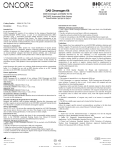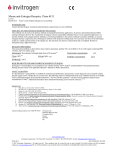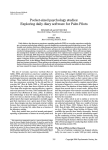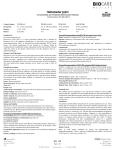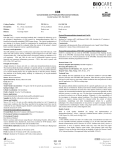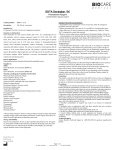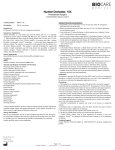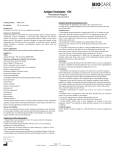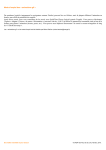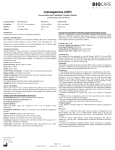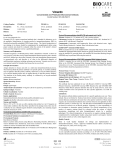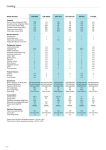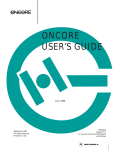Transcript
Universal Negative Control Serum ISO 9001&13485 CERTIFIED Mouse and Rabbit Negative Control Serum for the ONCORE Automated Slide Stainer Control Number: 901-6013-033015 Catalog Number: ORI6013 T60 Description: 60 tests Intended Use: For In Vitro Diagnostic Use Universal Negative Control Serum is a buffered solution of mouse IgG and rabbit IgG antibodies intended for use as a negative control reagent on formalin-fixed, paraffinembedded (FFPE) tissues in an immunohistochemistry (IHC) procedure performed on Biocare Medical’s ONCORE Automated Slide Stainer and visualized by light microscopy. The clinical interpretation of any staining or its absence should be complemented by morphological studies and proper controls and should be evaluated within the context of the patient’s clinical history and other diagnostic tests by a qualified pathologist. Summary and Explanation: Immunohistochemistry (IHC) permits the visual identification of specific protein antigens in tissues for diagnostic purposes. Following application of the primary antibody, the presence of a target antigen is visualized by the sequential application of an enzyme-antibody conjugate that binds the primary antibody, and a chromogen reagent, to produce a colored reaction product that is visible by light microscopy. Universal Negative Control Serum should be used in place of primary antibody to confirm performance of mouse and rabbit detection systems and evaluate any staining that may occur in the absence of primary antibody. Universal Negative Control Serum is provided ready-to-use and is intended to be applied as defined by the staining protocols on the ONCORE Automated Slide Stainer. Known Applications: Immunohistochemistry (FFPE tissues) Reagents Provided: Universal Negative Control Serum is provided as a buffered aqueous solution of mouse IgG and rabbit IgG antibodies, with preservative, sufficient to perform a total of 60 tests: Universal Negative Control Serum (ORI6013 T60) 60 tests (15.5 mL) Reconstitution, Dilution and Mixing: Universal Negative Control Serum is provided ready-to-use. No reconstitution, dilution or mixing is required. Materials and Reagents Required But Not Provided: Reagents and materials, such as primary antibodies, chromogens and ancillary reagents are not provided. Refer to the ONCORE Automated Slide Staining System User Manual for a complete list of materials and reagents required. Storage and Stability: Store at 2ºC to 8ºC. Do not use after expiration date printed on vial. Instructions for Use: Universal Negative Control Serum is provided in vials ready for use on the ONCORE Automated Slide Stainer. Uncap the vial and place in the ONCORE reagent tray. The ONCORE Automated Slide Stainer will apply reagent as required in the selected protocol. Limitations: These reagents have been optimized for use with ONCORE antibodies and ancillary reagents. The protocols for a specific application can vary. These include, but are not limited to fixation, heat-retrieval method, incubation times, and tissue section thickness. Third party primary antibodies may be used on the ONCORE Automated Slide Stainer; however, appropriate antibody concentration may depend upon multiple factors and must be empirically determined by the user. Ultimately, it is the responsibility of the investigator to determine optimal conditions. The clinical interpretation of any positive or negative staining should be complemented by morphological studies using proper positive and negative internal and external controls as well as other diagnostic tests. Quality Control: Refer to CLSI Quality Standards for Design and Implementation of Immunohistochemistry Assays; Approved Guideline-Second edition (I/LA28-A2) CLSI Wayne, PA USA (www.clsi.org). 2011 Precautions: 1. This product is intended for in vitro diagnostic (IVD) use. 2. This product is classified as non-hazardous based on the concentrations and hazards of the components, in compliance with the Globally Harmonized System of Classification and Labeling of Chemicals (GHS), the US OSHA Hazard Communication Standard (HCS), and European Union Classification, Labeling, and Packaging (CLP) regulations. 3. Specimens, before and after fixation, and all materials exposed to them should be handled as if capable of transmitting infection and disposed of with proper precautions. Avoid contacting the skin and mucous membranes with reagents and specimens, and follow standard laboratory precautions to prevent exposure to eyes and skin. If reagents or specimens come in contact with sensitive areas, wash with copious amounts of water. (3) 4. Microbial contamination of reagents may result in an increase in nonspecific staining. 5. The SDS is available upon request and is located at http://biocare.net/. Troubleshooting: Follow the reagent specific protocol recommendations according to the data sheet provided. If atypical results occur, contact Biocare's Technical Support at 1-800-542-2002. References: 1. Taylor CR, Cote RJ. Immunomicroscopy: A Diagnostic Tool for the Surgical Pathologist. 3rd Ed. Philadelphia: Saunders Elsevier, 2006. 2. Dabbs DJ. Diagnostic Immunohistochemistry: Theranostic and Genomic Applications. 3rd Ed. Philadelphia: Saunders Elsevier, 2010. 3. Clinical and Laboratory Standards Institute (CLSI). Protection of Laboratory Workers from Occupationally Acquired Infections; Approved Guideline-Fourth Edition (M29-A4) Wayne, PA 2014. Refer to the appropriate antibody data sheet for the recommended staining protocol. Refer to the ONCORE Automated Slide Staining System User Manual for detailed instructions on instrument operation and additional protocol options. Page 1 of 1
